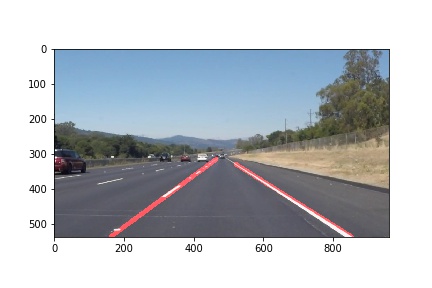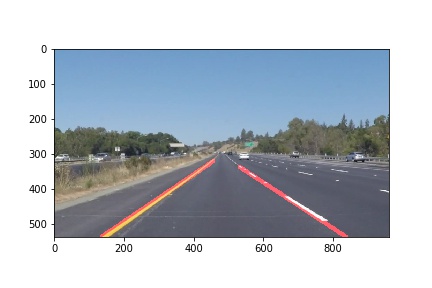Finding Lane Lines on the Road
The goals / steps of this project are the following:
- Make a pipeline that finds lane lines on the road
- Reflect on your work in a written report
1. Describe your pipeline. As part of the description, explain how you modified the draw_lines() function.
My pipeline consisted of 5 steps.
- Converting the images to grayscale.
- Applying Gaussian Blur to the grayscaled image.
- Detecting edges based on Canny Edge Detection.
- Getting only interested region.
- This region must be a polygon that fully contains both left and right lanes and at the same time it must exclude other region potentially causing confusion (e.g., region considered as the lane like white car).
- Finding lines using Hough Transform with the input of detected edges (i.e., output of Canny Edge Detection).
The main challenge of the pipeline implementation is understanding high level concepts to the implementation details including API usages and the determination of parameters. To decide parameters, we must consider given conditions and meaning of each argument of APIs.
- For Canny Edge Detection, since it takes advantage of the gradient and the range of gray pixels must be [0 - 255], the threshold must be one of values in [1 - 254]. We can assume that bright lanes that humans can recognize (e.g., white, yellow) have big enough gradients. Thus, we can set big thresholds (e.g., 150 for high_threshold). According to the know-how ratio between low_threshold and high_threshold (i.e., 1:3), I set the low_threshold as 1/3 of high_threshold.
- For Hough Transform to find lines, I used (1, numpy.pi/180, 10, 15) as (rho, theta, threshold, min_line_length). This setting decides it is a line if there are more than 10 points in the grid of (1, numpy.pi/180) and the line is bigger than 15. I assumed that the line is a set of continuous points and "continuous points" must be close enough. In other words, even small grid (e.g., 1, numpy.pi/180) must contain many points if it is a line. I found the exact value based on trials and errors. I adopted the similar intuition to set the min_line_length (i.e., how many "continuous points" are needed for a line).
In order to draw a single line on the left and right lanes, I added the connect_lines() function. The basic assumptions are
- There are only two lanes (i.e., left and right).
- Each lane is a straight line (i.e., not curved)
- If we make a lane longer, it must be close to lines that is a part of the lane.
- Lines not contained in a lane must have different slopes from the slope of the lane and the difference should be big enough.
Those assumptions are considered with virtual lanes, but we only have information for lines found by Hough Transform (i.e., the result of the pipeline). To get the lane, the function first finds the major line included in a lane. I considered the major line must contain the maximum number of lines when extending it. Since two lines are rarely intersected but can be considered as parts of the same lane, I allowed a small error. For each line L, the function gets y-distance from the extended L to two end points (x1, y1), (x2, y2) of other lines. For example, if L is slop * (x-x0) = (y-y0), the y-distance from (x1, y1) from the extended L is abs(y1-y0-slop*(x1-x0)). After getting the first major line, it extends the major line to lines that have similar slopes to the major line (by getting maximum and minimum x-values). Then, it extends the major line to the bottom of the image (i.e., y-value == y-size). It does the same thing to find the second major line, but only difference is to skip lines that have not big enough slope difference from the first major line when searching the second major line.
Results are shown as:
First, I assumed many things and it means there are many limitations in the current implementation. For example, I assumed lanes are straight. It does not work well for curved lanes.
Second, I fixed parameters (e.g., for Canny Edge Detection and Hough Transform). I guess this works fine for a small set of images, but the performance will be seriously bad when testing it against a large set of images. For example, the region of interest is very critical to the result. If some images having many white objects (e.g., white cars) in the fixed region of interest, then there will be so many detected edges from Canny Edge Detection.
A possible improvement would be to find a better transform to detect curved lanes. I am not sure but I think we need another mathematical theory to handle curved lanes. In particular, when the angle of curve is changed quickly (e.g., small circle), I guess Hough Transform cannot find the curved lane (even when we set the parameters very well).
Another potential improvement could be the adaptive parameter selection. We need an algorithm to automatically determine better parameters for the given input.

